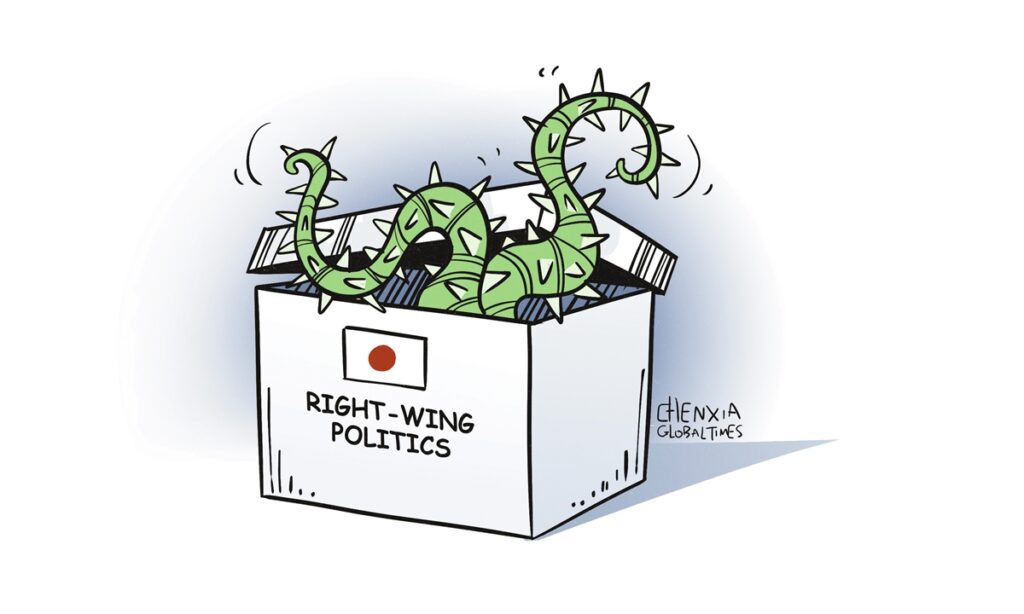The political maneuver of Japanese Prime Minister Fumio Kishida’s ritual offering at Yasukuni Shrine, a symbol of Japan’s militaristic past, on Thursday, which marked the 79th anniversary of Japan’s surrender in World War II, once again highlights a troubling resurgence of Japan’s militaristic agenda.
Kishida announced his resignation on Wednesday, but he “persisted” in sending ritual offering at Yasukuni Shrine the following day. This marks Kishida’s third consecutive year of doing so. Other Japanese politicians, including Defense Minister Minoru Kihara, visited Yasukuni Shrine for “worship.”
Yasukuni Shrine is a symbolic tool of Japanese militarism. It “honors” 14 Class-A war criminals, and worshiping or paying tribute there is inextricably linked to denying Japan’s aggressive history.
As Kishida steps down, his “legacy” leaves Japan grappling with poor economic performance, political scandals, and growing right-wing tendencies. Kishida’s repeated offerings at Yasukuni Shrine reveal his lack of deep reflection on historical issues as he attempts to whitewash Japan’s history of external aggression and colonial rule.
In recent years, continuing the rightward shift spearheaded by late former prime minister Shinzo Abe, Kishida has sought to revise the constitution, and allowed Japan’s internal and external policies to be steered down a dangerous path under the influence of the US’ Indo-Pacific Strategy. His “final” offering at Yasukuni Shrine before he leaves office will further fuel the toxic right-wing elements in Japan’s future political landscape.
The shift toward right-wing politics in Japan is not a recent development. Annual visits to Yasukuni Shrine have become a symbol of right-wing efforts to promote militarism. This is part of an attempt to whitewash the history of aggression and advance the process of “normalizing” the nation.
Japanese politicians sending ritual offerings or worshiping at Yasukuni Shrine aim to challenge the international order established after World War II and Japan’s pacifist Constitution. Under the banner of “normalizing” the nation, Japanese right-wing forces are eager to strengthen the country’s military capabilities. By aligning with the US as its pawn in the Asia-Pacific region, they are inflaming nationalist sentiments, inviting extraterritorial forces, and destabilizing the region. “These actions not only exacerbate tensions between Japan and its neighbors but also create geopolitical opposition, undermining regional peace and stability,” said Xiang Haoyu, a research fellow at the China Institute of International Studies..
Japan’s moves have aroused the high vigilance of the international community, especially Asian countries that were once victims.
Some Japanese politicians’ despicable behavior on the Yasukuni Shrine issue is a blasphemy against historical justice and a serious injury to the feelings of the people of victimized countries in Asia, including South Korea and China. In April, South Korea expressed “deep disappointment and regret” over Kishida and other Japanese officials’ ritual offerings to the Yasukuni Shrine. China has also urged “the Japanese side to face up to and reflect on its history of aggression, take concrete actions to make a clean break with militarism, and do not cause further loss of trust to its Asian neighbors and the international community.”
Unfortunately, Japan has shown no remorse. This time, Kishida’s offering to the shrine is, without a doubt, another troubling and reprehensible political gesture. History, as a mirror, reflects on current political behavior. The ritual offering at Yasukuni Shrine today will undoubtedly heighten anxieties about the direction of Japan’s political landscape moving forward.
For years, Japan has been trying to overcome the political stigma of being a defeated country from World War II. However, taking the wrong path could ultimately lead to its downfall.
GT




